|
|
Hambletonian

|
|
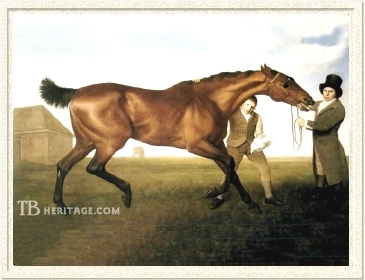 |
|
|
By David Wilkinson, author of Early Horse Racing in Yorkshire and the Origins of the Thoroughbred (Old Bald Peg Publications, Old Byland, York; 2003). ©David Wilkinson, 2005. All rights reserved.
Hambletonian (1792-1818) was one of the greatest racehorses of the late 18th century and arguably in the top one hundred thoroughbreds of all time. He was bred by John Hutchinson of Shipton-By-Beningbrough just north of York, and foaled in 1792. He was of impeccable breeding, by King Fergus and a grandson of both Eclipse and Highflyer. His owners and connections were equally interesting. In his racing career he won every race but one, including the St. Leger at Doncaster, but he was perhaps more famous for his great match against Diamond at Newmarket in 1799. George Stubbs has perpetuated him in a wonderful life sized portrait, and he is a link from Eclipse to many modern racehorses.
Hambletonian was named after the historic racing area on the edge of the North Yorkshire Moors, situated at 1000 feet, at the top of Sutton Bank, near Thirsk. He won his first race there on May 14th, 1794 in "A sweepstake of 15 guineas each for 3 year old colts, 8sts, fillies 7sts. 11lbs. over two miles." He was listed as a bay colt of Mr. Hutchinson's" and is not to be confused with an earlier Hambletonian who raced at Hambleton in the early part of the 18th century, or the American horse of the same name.
The Breeder - John Hutchinson
John Hutchinson was born at Hutton Rudby, of a farming family, in North Yorkshire. He began as a stable boy and jockey at Hambleton. The Hambleton 100 Guineas of Saturday August 17th 1751 established him on the path that led him to become a trainer, breeder and estate owner when he won the race on Sir Robert Eden's Miss Western. His passion for racing had developed from his visits to the nearby old Northallerton track. The Druid recounts Hutchinson's first foray into the betting ring: "There thank God, I shall never want for money again." He later trained at Malton, especially for Sir Peregrine Wentworth, of Toulston Lodge, Tadcaster, and Lord Grosvenor. After acquiring the Shipton estate he purchased King Fergus, previously owned by Dennis O'Kelly, and died a wealthy man.
Sold to Sir Charles Turner of Kirkleatham
At the August York race meeting of 1795, Sir Charles Turner (1773-1810), of Kirkleatham, near Redcar, was fortunate enough to purchase from Hutchinson Hambletonian, Beningbrough and Oberon for 3000 guineas. Hambletonian won two sweepstakes at the same York meeting and on September 22nd at the Doncaster meeting won the St. Leger. On the same afternoon Beningbrough won matches for 500 gs. and 200 gs. The following day Hambletonian won the Doncaster Cup and Beningbrough the Doncaster Stakes.
|
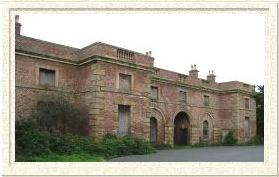
Carr's stables at Kirkleatham. Photo ©David Wilkinson
| |
The landowning Turner family occupied Kirkleatham Hall, remodelled by John Carr the Yorkshire architect. It was demolished in 1956 but his stables of the 1730s remain in a ruined state.
In 1796 Turner married Theresa Newcomen, but, as a condition of the marriage, her father insisted Charles give up his racing activities. As a consequence Hambletonian was sold to Sir Henry Vane-Tempest of nearby Wynyard Hall in County Durham across the Tees from Kirkleatham. |
After Turner's death, Theresa married Colonel Vansittart, who bred The Flying Dutchman, trained at Spigot Lodge, Middleham, by John Fobert. The Flying Dutchman ‚ Voltigeur match of 1851 was the last great 'match' to be run at York. The Flying Dutchman belonged to Lord Eglinton and Voltigeur to Lord Zetland.
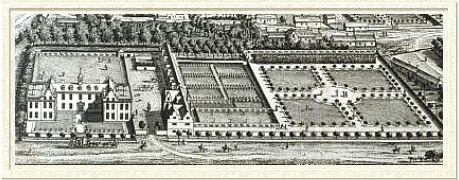
The Turner seat at Kirkleatham before its remodeling in the 19th century
Sir Henry Vane-Tempest
Sir Henry was immensely wealthy from his landholdings in the northeast of England and their associated collieries. He married Catherine Macdonnell, the Countess of Antrim, in April 1799, and produced Frances Ann (b. 1800), his only legitimate daughter and heiress. Sir Henry died on 1st August 1813 leaving Frances Anne, aged 13, as one of the richest girls in the country.
|
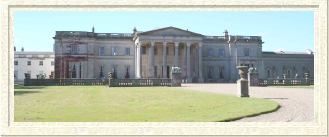
Wynyard, Co. Durham. Photo ©David Wilkinson
| |
Governesses at Wynyard brought her up as a lonely child, with her father absent for long periods and her mother regretting her martial choice. In London she was made a Ward of Chancery, with her mother and aunt as joint guardians. |
Frances Anne was an attractive young lady and eventually wished to marry Charles Stewart (1778-1854), the brilliant diplomat and soldier, who became the 3rd Marquess of Londonderry. Charles Stewart was half brother to Viscount Castlereagh, the Foreign Secretary and diplomat at the Congress of Vienna. The proposed marriage caused family ruptures and it required the Lord Chancellor to settle the issue but they were married on 3rd April 1819. Her capital established the financial stability of the Londonderrys and in recognition they later became the Vane-Tempest-Stewarts by petition to Queen Victoria in 1888.
An unflattering description of Sir Harry is quoted by Fairfax-Blakeborough from Raike's Diary:
"Saturday, May 21st, 1837. Lord and Lady Londonderry have left Paris for London. Her father Sir Harry Vane-Tempest, from whom she inherited all the Wynyard property, was one of the handsomest men of his time, but one of the hardest livers. He married the Countess of Antrim, and heiress to the Glenarm property in Ireland, which, added to his own income, rendered him one of the richest commoners in England. He was a very expensive man, fond of hunting, cock fighting, and the Turf, but not addicted to play. He once attracted great notoriety in Hyde Park on a Sunday by riding as a hack a celebrated racehorse who in the preceding week had won for him the St. Leger Stakes at Doncaster, of immense value. He was a good natured man though not of a refined manner, as may be inferred from the bet he once made with Harvey Aston, that he would knock down the first man that came into the stand at Newmarket. In those days there still existed among the men of fashion some vestige of the wild outrages of the Mohawks, as they were justly termed. Sir Harry Vane Tempest's most fatal passion was the bottle, which he carried to a great extent. I once passed a week with them at Wynyard, and though the dinner hour was not then unusually late, he would seldom be induced to get up from the table till five or six in the morning, and then he would not always retire to rest, but sometimes would put on his morning dress and walk over the estate with his bailiff. This irregular life soon wore out a naturally strong constitution, and he died at Wynyard of a fit in 1813, when he could not have been more than 40. His estates and collieries, which are of immense value, are now the property of Lord Londonderry. Lady Antrim, after the death of Sir Harry Vane married a Mr. Phelps, a man of no family, but celebrated for his singing talents, to whom she became attached. She was very proud of her descent from the Lord of the Isles, and said that when Lady Frances, her daughter, was an infant at Glenarm, every year Glengarry, the head of the Scottish clan, came over in a boat to do homage to the child of his sovereign liege."
The Hambletonian ‚ Diamond Match of 1799
The Hambletonian-Diamond match took place on 25th March 1799 over the Beacon Course at Newmarket. As a six year old Hambletonian took part in a north-south match at Newmarket for 3000 gs. over the four mile Beacon Course against Mr. Cookson's Diamond. Frank Buckle, the leading jockey of his day, rode Hambletonian. The race aroused enormous interest in Yorkshire and many travelled to Newmarket to support their champion - who won by half a neck amid 'a hurricane of applause.' Hambletonian started at 5 to 1 on with side betting estimated at 200,000 - 300,000 guineas. The Beacon Course was a straight four miles and two furlongs instituted in Charles II's time and became disused in the early 19th century. The time for the match is variously given as 7 minutes 15 seconds and 8 minutes and 30 seconds.
|
| 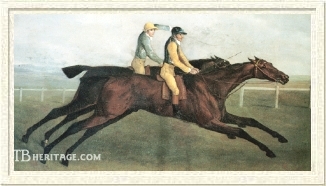
|
| The match |
In recognition of Hambletonian's great victory over Diamond, Sir Henry commissioned George Stubbs (1724-1806) to paint the horse in 1799. Stubbs was, of course, the greatest horse painter of his day. At the time of the commission he was at the height of his painting skills, though elderly at 75, and hard up. Sir Henry was young, wealthy and impetus, and in the same year married the Countess of Antrim. Stubbs and Sir Henry did not get on well and disagreed over the painting with Stubbs having to resort to the courts to obtain payment.
The match was a fiercely contested and both horses were reported to have been cut and goaded with whip and spur. Stubbs has eliminated injury from the painting, but it is a wonderful portrayal of a horse in exhaustion at the end of a great race. There is controversy as to the origin of the present painting. It is suggested that there were to be two paintings, but certainly only one survives. It is possible that Stubbs wished to paint a portrait depicting solely a large image of the horse against a neutral background, in the manner of Whistlejacket, painted for Lord Rockingham in 1762 (now in the National Gallery).
Perhaps Sir Henry persuaded Stubbs to add to his original work and paint in the background and especially the two figures on the right. The individual holding the rein, in the top hat, was thought to be Francis (Frank) Buckle (1767 -1832) the leading jockey of the time and winning rider of Hambletonian for the match, but it now seems more likely that it is Thomas Fields (1751-1810). Fields was Vane-Tempest's trainer at Silvio Hall, Richmond. The name of the stable boy is unknown, but it is of interest that his hand, which appears over the lower part of the horse's neck, is too long to be anatomically correct. It adds weight to the theory that it was painted in at a later time.
The enormous life size painting (twelve feet by seven) after being originally at Wynyard and later the library at Londonderry House on Park Lane (now the site of the Hilton Hotel) is now on the wall above the staircase landing at Mount Stewart, where it is owned by the National Trust.
Hambletonian lost only one race at the York meeting of 1796 when he ran out of the course in a sweepstake having started at 7 to 4 on. |
| Hambletonian's Winning Racing Record |
| Location |
Race |
Date |
| Hambleton |
Sweepstake for 60 guineas |
1794 |
| York (Spring) |
Sweepstake for 20 guineas |
1795 |
| York |
Sweepstake for 100 guineas |
1795 |
| Doncaster |
St. Leger |
1795 |
| Doncaster |
Gold Cup |
1795 |
| York |
Subscription Purse of £227 |
1796 |
| York |
Ladies Plate |
1796 |
| Doncaster |
Gold Cup |
1796 |
| Newmarket |
Gold Cup |
1796 |
| Newmarket |
1000 guineas match against Patriot |
1796 |
| Newmarket |
300 guineas match against Aimator |
1797 |
| York |
Great Subscription Stakes |
1797 |
| York |
Subscription Stakes (beat.Beningbrough) |
1797 |
| Doncaster |
Doncaster Stakes |
1797 |
| No Races |
1798 |
| Newmarket |
3000gs Match v. Diamond |
1799 |
| York |
Great Subscription Stakes |
1800 |
|
Hambletonian himself is buried in the grounds of Sir Henry's former home, Wynyard Park, Co. Durham where he died 28th March 1818.
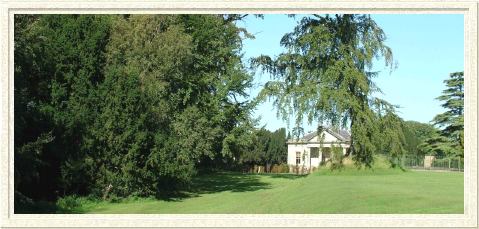
Hambletonian's Burial Place in the grounds of Wynyard with the former estate dairy in the background. (Courtesy Sir John Hall)
Francis (Frank) Buckle (1767-1832)
Frank Buckle, who rode Hambletonian in the great match against Diamond, was a rare man of honour and integrity, at a time when racing types (and jockeys in particular), were corrupt and often violent.
The son of a Newmarket saddler, he had for the time a unique combination of skill and honesty. Buckle
was an early example of a jockey who became a popular hero, with 27 Classic victories to his name,
accumulated before his retirement at the age of 65. This record was not beaten until the arrival of
Lester Piggot.
Buckle's family came from Westmoreland and claimed a descent from a Lord Mayor of London. His father died when he was 12 and an aunt brought him up. He saw no future in saddlery and became an apprentice to Richard Vernon, who noticed and developed BuckleÌs riding skills. As a boy of 16 he walked out Mr. VernonÌs Wolf on the Rowley Mile at Newmarket. At the time he was a "feather" at only 3st 13lb, but later he had a riding weight of 8st 7lb, which he was able to maintain with ease. Nevertheless he joined with other jockeys in an end of season feast with a goose as the centrepiece. It was said of him, "The Governor, there was nothing flash or big about him, except his heart and nose." At a time when jockeys were permitted to bet, he often rode against his own financial interest.
|
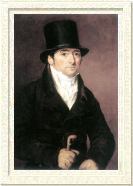
Frank Buckle
| |
He took part in a bizarre race at York in 1805 when he rode Allegro against Alicia Thornton on Colonel
Thornton's Louisa. She won, wearing a purple cap and waistcoat, nankeen coloured skirts, purple shoes
and embroidered stockings. She did have a considerable weight advantage.
Buckle was highly regarded for his stamina if not (allegedly) for his intelligence. He lived on his
farm at Orton Longueville near Peterborough, and would make the 92 mile round trip to Newmarket to be home after racing by six o clock.
At the Newmarket Craven meeting of 1799 Buckle rode Hambletonian with legendary calm. Sir Henry
Vane-Tempest said to him "I would give half my fortune for a nerve as yours." |
His first classic win was with Lord Grosvenor's John Bull in the 1792 Derby; he later rode Daedalus
(1794 Derby), Nike (1797 Oaks) and Bellina (1799 Oaks) for the Earl. He later often rode for Robert
Robson, "The Emperor of trainers," whose patrons were the 3rd and 4th Dukes of Grafton. He won eleven classics for them. Buckle's last classic races were the Guineas of 1827 with Turkoman and Arab, when he was 60. He died on 5th February 1832, just 3 months after wearing his last silk. He is buried in a sumptuous grave in his local churchyard.
"No better rider ever crossed a horse; Honour his guide, he died without remourse, Jockeys attend
from his example learn The meed that honest worth is sure to earn."
Hambletonian's Legacy
Hambletonian may have been the greatest racehorse of his time but his immediate progeny were regarded, as lack lustre. Hambletonian went to stud at Hornsey's stables in Middlethorpe, York at the modest sum of 10 guineas per mare. One of his early coverings was Squire Garforth's Rosalind, by Phoenomenon who produced Whitelock, and continued the sire line. Another son was Doncaster Cup winner Camillus, who, located at the Sykes Sledmere Stud on the Yorkshire Wolds, was later a moderately successful sire. Nevertheless the "great channel" of his line from Eclipse through King Fergus was continued through, Whitelock (1803) to Blacklock (1814) and on to St. Simon.
The Druid said of Whitelock:
"...there was nothing in his appearance, which warranted him becoming so celebrated through Blacklock, and of the last-named he told us Mr. Sylvester Reed (who bought Whitelock fromäthe Sykes at Sledmere) said 'he dare not venture on his forelegs, as his fetlocks and pasterns, almost formed a straight line. He was a great black-brown, with a stride, which required half-a-mile to settle in; a head like half a moon, with eyes quite in his cheeks, and quarters and shoulders as fine as horse could wear. Perhaps to the eye he might be rather light in the fore-ribs, though the tape told a different tale, and the hocks of his stock generally stood well away from them, a formation which requires great strength in loin to support. The hunting field was quite as much their sphere as the racecourse."
Whitelock was sold unnamed to Tatton Sykes. His racing career being somewhat more illustrious than The Druid gives credit with winning races at Durham, Pontefract and Northallerton on the northern circuit. The Sykes sold him for the then large sum of £300 to Sylvester Reed, who declined an offer of £50 for his son Blacklock from Mr. Moss in York, who had livery stables in Minster Yard.
Mr. Moss had purchased Blacklock's dam, The Coriander Mare, for £3 and had her turned out on York's Clifton Ings (site of York Races before the move to the Knavesmire) where the foal Blacklock, would jump up to greet him. Moss said of him in his Yorkshire dialect "ez wick ez a wezzill."
Mr. J. Kirby of York bought Blacklock from Moss and after winning a couple of races passed him on to Richard Watt of Bishop Burton, a foxhunting squire and landowner. Kirby was a prominent in York racing circles and had an international reputation for his brave purchases of Thoroughbreds with an extensive export trade with Russia ‚ enough for him to charter transport vessels.
Blacklock was expected to win the 1817 St. Leger, starting at 5 to 4 on but was beaten by half a neck by Ebor, owned by Henry Peirse of Bedale at 100 to 4. Trainer Sykes' over-enthusiastic instructions to the jockey John Jackson at the Distance Post allowed J. Johnson to ease Ebor into the lead.
Blacklock continued the bloodline by siring Voltaire (1826) whose son Volitgeur (1847 led to the Galopin and Speculum lines. Blacklock died suddenly at Bishop Burton on 24th February 1831 after serving a mare called Laura. He was buried in the grounds but later exhumed and his skeleton preserved in the harness room.
Fairfax-Blakeborough says of Blacklock "...without him in the flesh, we should have had no Volitgeur, hence no Galopin, Beauclere, St. Simon, Memoir, La Fleche, Mimi, Donovan, St. Serf, Orme, Surefoot, Sheen and a host of others."
|
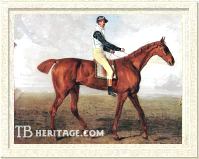
Hambletonian's son Anticipation
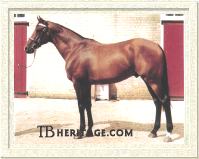
Fighting Charlie
| |
Hambletonian also sired the grey Doncaster Cup winner Camillus (1803), a fairly successful sire of such horses as Minna Dalby, Magistrate, Minister, Treasure (an influential broodmare), Consul (Doncaster Cup), and Oiseau (later sire of St. Leger winner Rowton).
Hambletonian's best son on the turf was Anticipation (1812), bred by Thomas Thornhill of Riddlesworth, out of the good broodmare Hyale, by Phoenomenon. He ran for five years, and won sixteen races, often carrying the highest weight, including the Ascot Gold Cup twice, the Oatlands at Ascot over 1-1/2 miles, Gold Cups at Burdedrop and Salisbury, several races over the 4 mile-2 furlong Beacon Course at Newmarket, and numerous matches. He broke down in 1819, running for the Cup at Blandford, and was purchased for the high price of 750 guineas by Lechmere Charlton for his stud, Ludford, at Ludlow. He was not a success as a racehorse sire, but he "...got many excellent hunters, well-known in Shropshire."
Postscript
Fighting Charlie, an 11th great-grandson of Hambletonian, owned by Lady Marie Bury, the oldest
surviving member of the Londonderry family, won the Ascot Gold Cup twice, in 1965 and 1966. |
Short Bibliography
Fairfax-Blakeborough J., Northern Turf History, (Vols. 1-3), c.1950
Orton John, Turf Annals of York and Doncaster, York, 1855
Dixon H.H., "The Druid," Scott and Sebright, 1862
Dixon H.H. "The Druid," Silk and Scarlet, 1858
Fletcher J.S., The History of the St. Leger Stakes, c.1926
Longrigg R., The History of Horse Racing, 1972
--David Wilkinson
|
|
|

